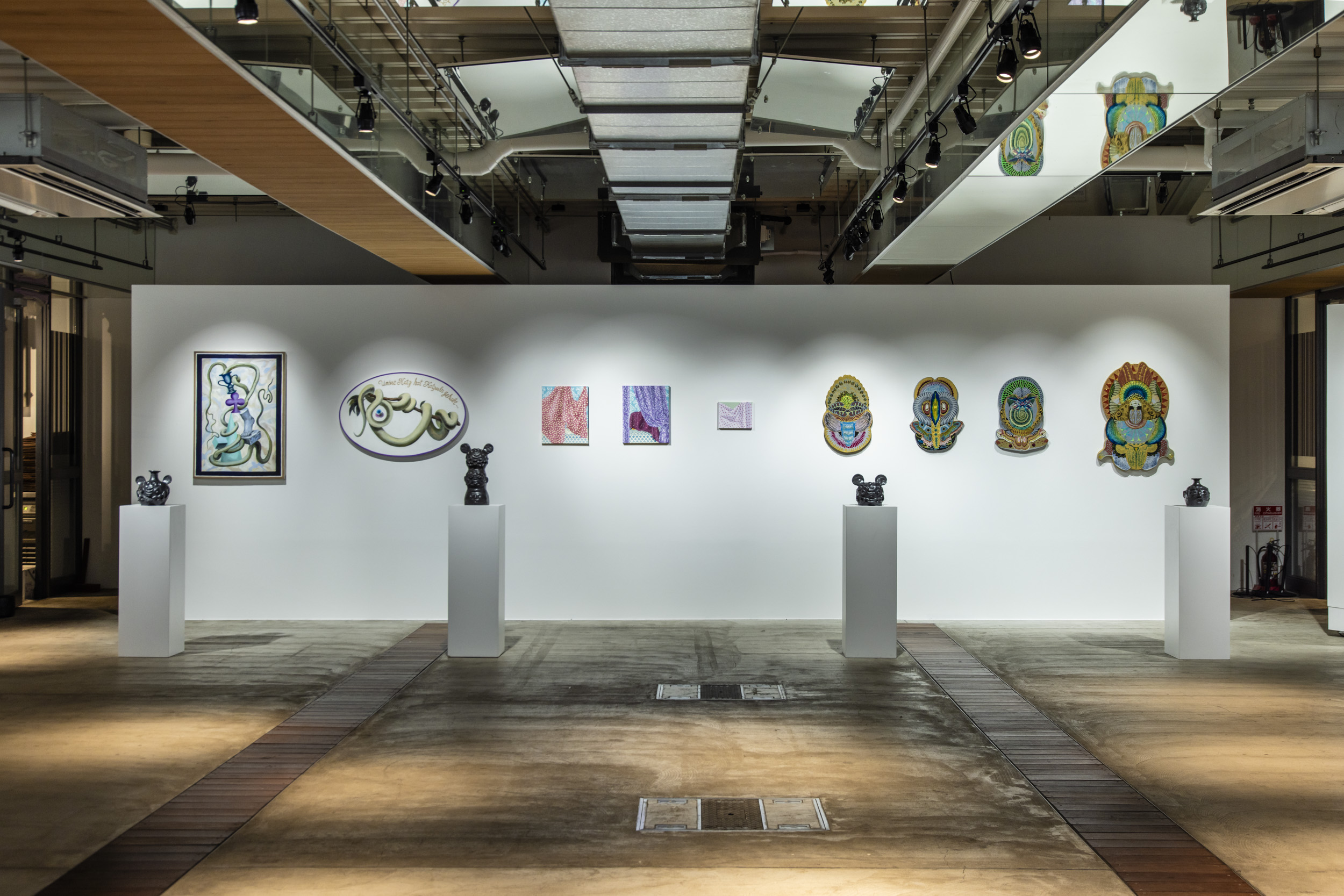展示レビュー
WHAT CAFE EXHIBITION vol.34
『TOPOLOGY』 展示レビュー
『TOPOLOGY』 Exhibition Review
『TOPOLOGY』 Exhibition Review
『TOPOLOGY』 Exhibition Review
2024/02/25 | レビュアー:小川喜之 レビュアー:Yoshiyuki Ogawa レビュアー:Yoshiyuki Ogawa レビュアー:Yoshiyuki Ogawa
東京・大阪・京都の3都市を拠点に先鋭的な企画展やアーティストを発信しているギャラリーによるアートプロジェクト、「DELTA」。<br /> DELTAは既存の枠にとらわれない視点で、ギャラリー・アーティスト・コレクターをつなぐ新たな「場」の創造を目的にアートフェア、エキシビションの形式を通して活動している。<br /> <br /> 「WHAT CAFE EXHIBITION vol.34 WHAT CAFE × DELTA ”TOPOLOGY”」と題された今回の展覧会は、関東と関西を拠点に活動する若手から中堅のディレクター計10名が参加し、関東と関西のディレクターが2名1組のペアを組み共同ディレクションのもと、5つのプレゼンテーションによって展示が構成されていた。<br />
DELTA is an art project based across Tokyo, Osaka, and Kyoto, run by galleries that present cutting-edge exhibitions and artists, and brings an entirely fresh perspective to art fairs and exhibitions, where it aims to create a new “space” to bring together galleries, artists, and collectors.<br /> <br /> For this exhibition—WHAT CAFE EXHIBITION vol.34 WHAT CAFE × DELTA “TOPOLOGY”—ten young and mid-career directors based in Kanto and Kansai were grouped into five pairs, each consisting of one person from Kanto and one from Kansai, and created five jointly-directed presentations.<br />
まず、今回のタイトルである「TOPOLOGY」という言葉に馴染みがなかったので検索した。<br /> トポロジーは、何らかの形(かたち。あるいは「空間」)を連続変形(伸ばしたり曲げたりすることはするが切ったり貼ったりはしないこと)しても保たれる性質(位相的性質または位相不変量)に焦点を当てたものである。<br /> (wikipediaより引用)<br /> <br /> その概念を把握するにはとても時間がかかりそうなので、この企画のTOPOLOGYの要約をみると、<br /> ・位置や場所を表す言葉「topo」と学問分野を表す言葉「logy」を組み合わせた言葉<br /> ・何らかの形あるいは空間を連続変形しても保たれる隠れた性質に焦点を当てたもの<br /> ・繰り返される現象の一周期のうち、ある特定の局面や位置<br /> ・収束や連続の概念を定義するために、集合に与える構造<br /> とあった。<br /> <br /> ギャラリーという空間「topo」の中に存在する作家の作品(またはその構造、思考など)「logy」を繰り返される現象と置き換え、そこから2つのギャラリーの共鳴する部分を見つけ出し、その点と点を繋いだ線を見せるプレゼンテーションなのでは?と私の中で解釈した。<br />
Firstly, because the title word “topology” was unfamiliar, we looked it up.<br /> <br /> Topology is concerned with the properties (topological properties or topological invariants) that are preserved when a given form (a shape, or alternatively a ‘space’) is subjected to continuous deformations (such as stretching and bending, but not cutting and pasting, etc.). (From the relevant Japanese Wikipedia page)<br /> <br /> These concepts seem like they would take a while to understand, so for the purposes of this exhibition, “topology” was summarized as follows:<br /> <br /> • A word composed of “topo,” which means location or place, and “logy,” which denotes a field of study.<br /> • Centered on hidden properties that are preserved under continuous deformations of a given form or space.<br /> • A specific phase or position within the cycle of a recurring phenomenon<br /> • A structure assigned to a set in order to define concepts like convergence and continuity<br /> <br /> If for the recurring phenomena we substitute the artists’ works (or structures, or ideas)—the “logy”—that exist inside the space, or “topo,” that is the gallery, then perhaps we can find the elements that resonate between two galleries and reveal the lines that link these points? That was my interpretation of what these presentations could do.<br />
私の仕事柄、作家をフィーチャーする事だけに焦点を当てるのではなく、過去の仕事の事例なども考慮し、その裏側ないし作家本人も意識していないカルチャーの部分を商品や企画に盛り込みたいと意識してオファーをするようにしている。<br /> そうすることで作家自身も思い入れのある仕事になるだろうし、それがカルチャーを醸成するものだと信じているためである。<br /> 私の経験として、知識の中の点と新たに得た情報の点が繋がり線となった瞬間に脳内のアドレナリンが分泌されるような感覚があり、今の仕事をやめられない大きな要素となっている。<br /> <br /> 今回の企画展では、その企画内容が十分に伝われば鑑賞者に対してそのような高揚感を与えることができる展覧会なのではないかと考えが至った。<br /> 10あるギャラリーの中にひとつでも自分の興味を引くギャラリーや作家がいれば、そこから数珠繋ぎのように点と点を繋ぐことができ、よりそのギャラリーや作家への興味も深まり鑑賞する前の自分と比べ知識や経験を積むことができる。<br /> たとえどの作品も見たことのない状態であっても、今回新たに鑑賞したことでそこから知識の数珠繋ぎがはじまる。ただ、展示にはそのような背景のキャプションまではないので、数珠繋ぎをするには自身で調べたり自分なりの解釈をしてギャラリーや作家のことを深堀りする必要がある。<br /> それは決して現代では難しいことではなく、きっかけとしてはSNSを通じて気軽に情報を得ることができる。ただ、SNSの情報だけではあまりにも希薄(誰もが知り得る情報)なので、実際にギャラリーや展覧会に足を運び作家とコミュニケーションをとったり、時には過去の書籍や雑誌を漁ったり、その経験をすることで自身の知識を深めて独自の点と点を繋げた線を描けるようになるとより楽しめるのではないかと思う。<br /> <br /> 私としても今回新たに知ったギャラリーもあるので、東京だけではなく京都に行った際にも訪れるべき場所が増えたのは良い経験となる展覧会鑑賞となった。<br />
My work doesn’t just consist of featuring artists: I also think about examples of their past work, consider their hidden qualities or cultural aspects that the artists themselves aren’t aware of, and aim to incorporate these into the products and exhibitions we offer. Because this way, the artists themselves are more attached to what we’re doing, and I believe this is how culture is developed. Going by my own experience, my sense is that, at those moments when a line is formed between a point in my knowledge and a point in some newly acquired information, I get an adrenaline rush. This is an important factor in why I can’t stop doing this work.<br /> <br /> With this exhibition, it occurred to me that if this concept was properly conveyed to the visitors, they might be able to feel this sense of exhilaration. If even just one of the ten galleries or a single artist caught their interest, this has the potential to set off a whole chain of connections that could further boost their engagement with said gallery or artist, leaving them with greater knowledge and experience than before their visit.<br /> <br /> Even if one had never seen any of the works before, discovering them at the exhibition might launch an odyssey of new connections, new knowledge. But because the exhibition featured no contextual captions, this would require them to do their own research, to look into the gallery or artist after having come up with their own interpretations.<br /> <br /> This isn’t difficult to do in this day and age: as a jumping-off point, one can easily acquire information through social media. But this kind of information (available to anyone) is too shallow. Surely it’s more fun to learn to draw one’s own connecting lines, deepening one’s knowledge by actually going to galleries and exhibitions and communicating with the artists, or occasionally hunting through old books and magazines.<br /> <br /> For me, too, this exhibition provided a good experience: even I discovered galleries I hadn’t known about, and now I have new places to look up not only in Tokyo but also when I go to Kyoto.






